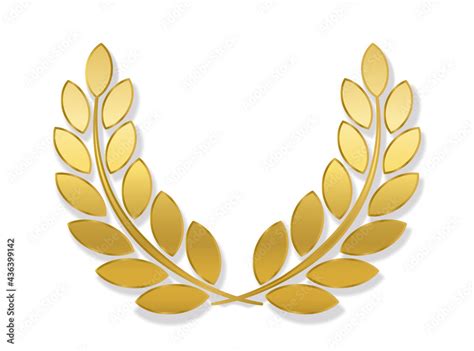Since ancient times, the crown of laurel hair has been a coveted symbol of honor, triumph, and achievement. Worn by victorious athletes, poets, emperors, and other esteemed figures, it serves as a tangible representation of excellence and accomplishment.

History of the Laurel Crown
The origins of the laurel crown can be traced back to ancient Greece, where the laurel tree was considered sacred to the god Apollo. According to Greek mythology, Apollo chased the nymph Daphne, who transformed herself into a laurel tree to escape his advances. In honor of Daphne, Apollo adopted the laurel as his sacred tree, and the laurel crown became a symbol of his patronage.
Over time, the laurel crown spread throughout the Roman Empire and beyond. Roman soldiers who emerged victorious in battle were awarded laurel crowns to signify their valor and achievement. In the 16th century, the laurel crown was adopted as a symbol of poetic achievement, particularly in England. Poets such as Shakespeare and Ben Jonson were often depicted wearing laurel crowns.
Symbolism of the Laurel Crown
The laurel crown holds a profound symbolism across cultures and eras. It represents:
Victory and Triumph: The laurel crown is most closely associated with victory, whether in battle, sports, or other competitive endeavors. It symbolizes the achievement of a lofty goal or the accomplishment of a remarkable feat.
Honor and Recognition: The laurel crown is bestowed upon those who have earned the respect and admiration of society. It signifies excellence, distinction, and the recognition of one’s accomplishments.
Wisdom and Knowledge: The laurel tree is also associated with wisdom and knowledge. The laurel crown can thus symbolize intellectual achievements, particularly in the fields of poetry, literature, and scholarship.
Immortality: In some cultures, the laurel crown is believed to convey immortality or eternal fame. It represents the enduring legacy of one’s accomplishments and the lasting impact of their work.
Applications of the Laurel Crown
Throughout history, the laurel crown has been employed in various contexts, including:
Ceremonies and Awards: The laurel crown is commonly awarded as a prestigious prize or honor to recognize exceptional achievements in sports, literature, art, and other fields.
Heraldry and Coats of Arms: The laurel crown is frequently featured in heraldry, representing nobility, honor, and power. It can adorn family crests, official seals, and other heraldic symbols.
Decorative Motifs: The laurel crown has inspired countless decorative motifs in art, architecture, and fashion. It can be found on sculptures, paintings, coins, jewelry, and other decorative objects.
Apothecary and Medicine: In traditional medicine, laurel leaves have been employed for their medicinal properties. The laurel crown may thus symbolize health, healing, and well-being.
Table 1: Laureates Crowned with Laurel Leaves
| Name | Accomplishment | Year |
|---|---|---|
| Sophocles | Greek playwright | 496 BC |
| Virgil | Roman poet | 19 BC |
| William Shakespeare | English playwright | 1616 |
| Napoleon Bonaparte | French emperor | 1804 |
| Winston Churchill | British Prime Minister | 1945 |
| Nelson Mandela | South African President | 1994 |
Table 2: Laurel Crowns in Heraldry
| Name | Country | Meaning |
|---|---|---|
| Crest of the British Monarchy | United Kingdom | Royal authority and power |
| Coat of Arms of the United States | United States | National sovereignty and independence |
| Coat of Arms of the Canadian Monarchy | Canada | Royal dignity and authority |
| Arms of the Vatican City | Vatican City | Papal supremacy and spiritual authority |
| Arms of the University of Cambridge | United Kingdom | Academic excellence and distinction |
Table 3: Medical Uses of Laurel Leaves
| Application | Benefits |
|---|---|
| Anti-inflammatory | Reduces swelling and pain |
| Antibacterial | Fights bacterial infections |
| Antiseptic | Prevents the growth of microorganisms |
| Digestive aid | Improves digestion and reduces gas |
| Respiratory support | Clears congestion and coughs |
Table 4: Laurel Crown in Popular Culture
| Title | Medium | Year |
|---|---|---|
| “The Laurel Crown” (poem) | Poetry | 1784 |
| “The Laurel Crown” (novel) | Literature | 1902 |
| “Laurel Wreath” (painting) | Art | 1927 |
| “The Laurel Crown” (film) | Cinema | 1949 |
| “The Laurels of Success” (song) | Music | 1972 |
FAQs
1. What is the significance of the laurel crown?
The laurel crown symbolizes victory, triumph, honor, wisdom, knowledge, and immortality.
2. How is the laurel crown awarded?
The laurel crown is typically awarded as a prize or honor in various fields, such as sports, literature, and the arts.
3. What does a laurel crown represent in heraldry?
In heraldry, the laurel crown represents nobility, honor, and power.
4. How is the laurel crown used in medicine?
Laurel leaves have been traditionally used in medicine for their anti-inflammatory, antibacterial, antiseptic, and digestive properties.
5. Are laurel crowns still used today?
Yes, the laurel crown is still used today as a prestigious symbol of achievement and recognition in various contexts.
6. How can the laurel crown inspire new ideas?
The laurel crown can inspire new ideas by symbolizing the pursuit of excellence, the recognition of success, and the enduring legacy of one’s accomplishments.
7. What is the creative new word for the laurel crown?
“Lauralia” could be a creative new word to describe the laurel crown, incorporating the Latin “laurus” (laurel tree) and the suffix “-alia” (abundance).
8. How can I incorporate the laurel crown into my own life?
You can incorporate the laurel crown into your life by setting goals, striving for excellence, and recognizing your achievements. You could also display a laurel crown symbol in your home or office as a reminder of your aspirations and accomplishments.
